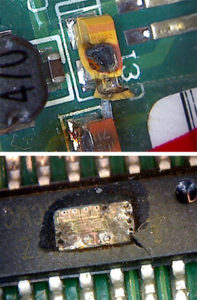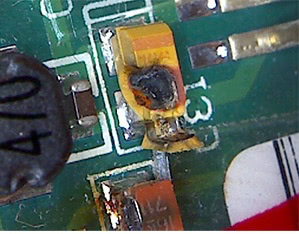This information was kindly provided by our supplier Huntron
Quick Tip – Protecting your Huntron Tracker
The most common reason a Huntron Tracker comes to the factory for repair is because it was subjected to a voltage or current surge through the front panel probes. Sometimes the damage is minimal and other times quite severe.
Huntron Trackers do have front end protection that is triggered when a voltage higher than 20Vpk is applied through the probes. When the over-voltage protection circuit is triggered the channel and range relays are set to an open state in an attempt to protect the Tracker. In most situations this protection functions quite well but in cases where the applied voltage is lower but the current available is high then the Tracker is at risk. This is usually the case when a charged capacitor is tested. The voltage potential may be low but when the capacitor is probed then it discharges through the Tracker. Damage can occur if the Tracker is set to a low resistance such as 10 ohms and in most cases the repair involves replacing damaged range resistors and relays.

In cases where a live circuit is tested with a Tracker the damage can be much worse. Users have told us that they have multiple sets of leads going to different instruments on their bench. When going to test a live circuit they accidentally grab the wrong probes, the Tracker probes in this case. We have seen upwards of 220V applied to a Tracker with predictable results as shown in the images below. Severe damage to the main Tracker PCB can result and in many cases requires the PCB to be replaced.
What can you do to protect your Tracker? Establish a set test procedure that reduces or eliminates the possibility of applying an external voltage to your Tracker.
– Disconnect any external power sources from the unit or circuit board under test. This can especially apply to Access Prober users who are automating power-on test measurements (.i.e. DMM and oscilloscope).
– Disconnect the board under test from other boards or power supplies in the assembly to help isolate it and reduce the risk from external voltages.
– ALWAYS safely discharge large capacitors on the circuit board under test before using your Tracker.
– If you have multiple test instruments on your bench find a way to distinguish which probes go where. Maybe have unique marks or colors.
– Disable or disconnect batteries or “super caps” that may be on the circuit board. This will also help in getting more stable signatures.
Prevention is the key to keeping your Tracker safe and avoiding expensive repairs.
View all of the Huntron Quick Tips by visiting the Huntron Technical Support web page
If you would like any more information on the Huntron Product Range, contact us.
